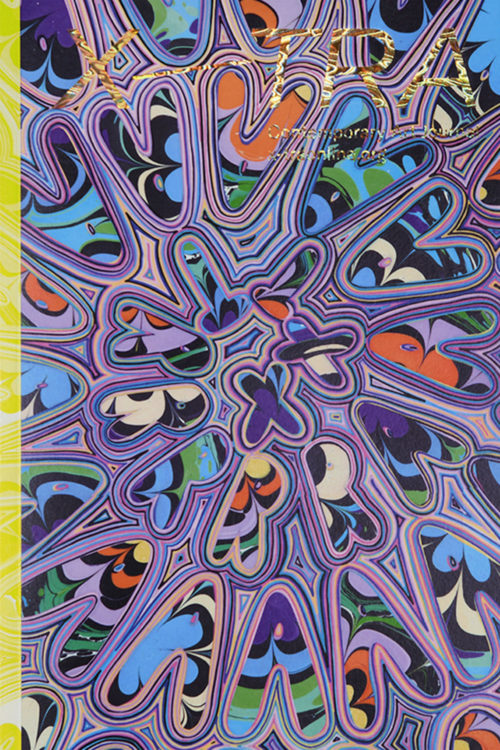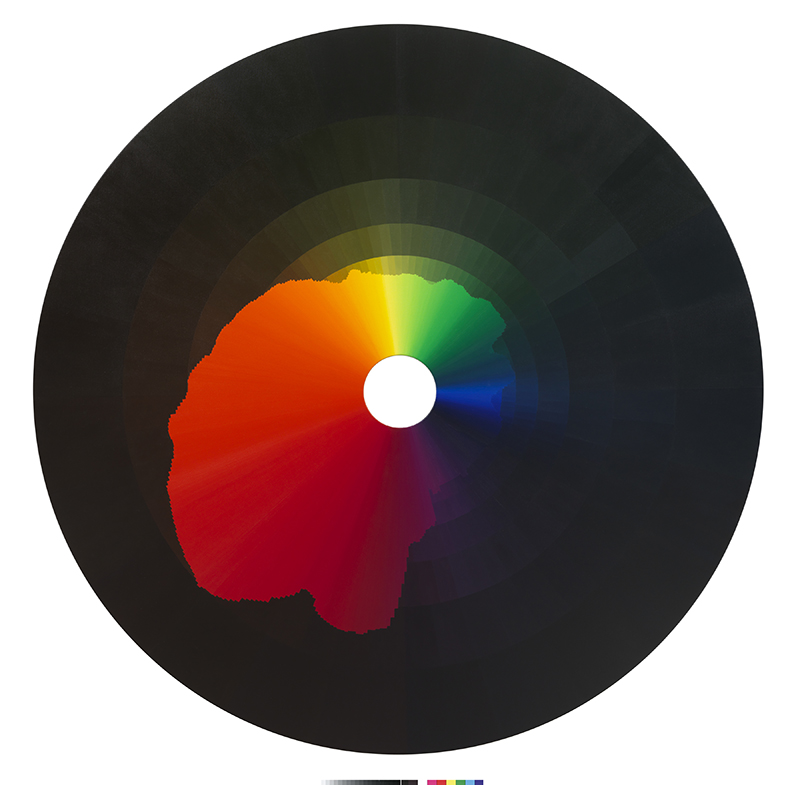
Olafur Eliasson, Light measurements: Reykjavik, 20 March 2011, 19:25 GMT, 2012. Oil on canvas, diameter 78 3/4 × 78 3/4 inches, center 9 7/8 × 9 7/8 inches. Courtesy of the artist and Tanya Bonakdar Gallery, New York/Los Angeles.
The title of Olafur Eliasson’s recent exhibition of paintings, Your light spectrum and presence, signals his attention to the experience of color and light, topics that have a long history of investigation in fine art and science. Eliasson’s practice is characterized by a technological imagination that produces wonder at the intersection of natural systems and aesthetics. The Weather Project (2003), Living Observatory (2021), Solar Energy (2022), and many of his other projects make use of sun, light, and natural cycles to produce seductive, immersive, and atmospheric experiences that are phenomenological rather than representational.
The exhibition at Tanya Bonakdar Gallery features two painting series: Colour experiment (2009–ongoing) and Light measurements (2011–12). Both projects draw on a historical pedigree with a rich philosophical background, including the works of renowned figures such as Johann Wolfgang von Goethe, Michel Eugène Chevreul, and Josef Albers. Their studies of light and color crossed disciplinary lines and inspired scientists and artists to explore relations of illumination, pigment, and visual perception.
Many of Eliasson’s Colour experiment paintings comprise vivid rainbows that emanate in circular bands around central areas of deep blue-black. From across the gallery, Colour experiment no. 113 and Colour experiment no. 105 (both 2021) look like glowing targets. As the viewer approaches, the spectral sequence of colors in the outer bands immerses the viewer in a luminous aura. Even closer, the paintings appear to bend, as the force field of color produces a dimensional distortion. These absorbing and absorptive works are saturated and refulgent at the same time, though the central dark areas of some suffer from a slightly shiny finish that produces a distracting reflection of the viewer and others in the exhibition space.
Eliasson’s investigations of the color spectrum—which is produced when light is refracted into its constituent wavelengths through water in the atmosphere or a prism—extend his ongoing explorations of human perception, natural phenomena, and visual perspective, which frequently manifest in his installations, sculpture, and two-dimensional works. The glowing circular canvases exhibited here prompt a technical discussion in which the history of color studies—artistic as well as scientific—is entwined with the development of optical technologies. These technologies focus, extend, synthesize, and fracture light—and the user’s attention.
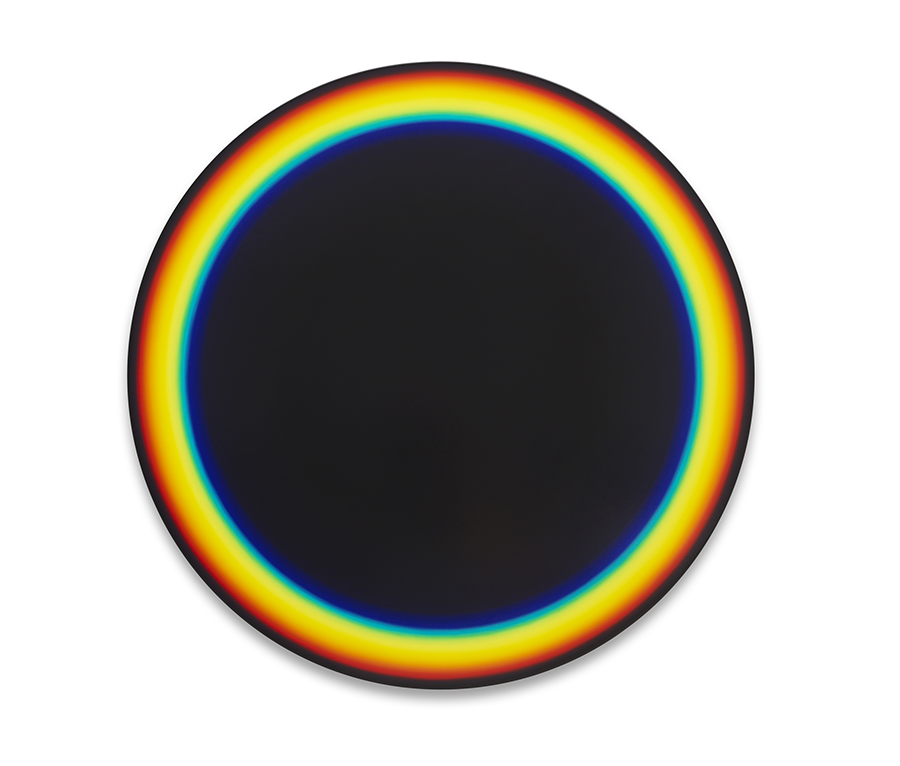
Olafur Eliasson, Colour experiment no. 101, 2020. Oil on canvas, 78 3/4 × 78 3/4 × 2 inches. Courtesy of the artist and Tanya Bonakdar Gallery, New York/Los Angeles.
In contrast to the floating, un-located Colour experiments, the Light measurements paintings are identified by highly specific coordinates, for instance, Light measurements: Reykjavik, 20 March 2011, 19:25 GMT and Light measurements: Reykjavik, 20 March 2011, 13:00 GMT. As the titles indicate, the hues in each work in the series are present in proportion to their presence in the light Eliasson observed and recorded at a specific time and place. But although one can see that the quantities of different colors in his asymmetrical compositions vary, the connection with light in a particular time and place is difficult to perceive. The circular compositions are reminiscent of color wheels; their painted surfaces are divided into segments that are continuous in value but comprised of discrete segments bounded by glitchy and pixelated edges. As a result, the color arrays spread across black backgrounds read like digital paint tool pick-wheels. Though Eliasson is not painting pixels, with their red-green-blue light emissions, the paintings borrow from that graphic vocabulary.

Olafur Eliasson, Colour experiment no. 101, 2020. Oil on canvas, 78 3/4 × 78 3/4 ×2 inches. Installation view, Tanya Bonakdar Gallery, Los Angeles, February 12–March 26, 2022. Courtesy of the artist and Tanya Bonakdar Gallery, New York/Los Angeles.
Perhaps more importantly, in Eliasson’s proposal of a link between light and time and place, a subtle but definite connection to the climate crisis emerges in this exhibition. Light is never innocent, the atmosphere is always inflected with moisture, pollutants, and specific properties that register in its colors as well as its chemistry. Light, in other words, can be diagnostic, indicative of the complex conditions of which it is an effect.
Eliasson’s Colour experiments began in 2009 as a collaboration with an unidentified chemist “to formulate a new color theory.”1 The goal was to create pigments to match each of the more than four hundred nanometers of the visible spectrum. While the Light measurements works are linked to specific place-time observations, the Colour experiments are meant to be an experiment in creating pigments to represent all visible light. However, light is not the same as pigment, and conflating the two is a conceptual error. This is a problematic aspect of the project. While Eliasson typically uses natural materials and forces directly, these works are representations—not presentations—of light. Paint on canvas can only simulate the spectrum of color.
This conceptual confusion is significant, because most of the paintings in Your light spectrum and presence are presented by the gallery and on the artist’s website as “experiments” with empirical foundations. Eliasson used a technical device called a cyanometer to produce the works. This tool was invented in the eighteenth century by the renowned natural scientist Alexander von Humboldt to take purportedly accurate measurements of the blue of the sky. While such techniques may provide a basis for producing a metrics of light, the measurements of a mechanical instrument are not the same as the optics of human perception. While the cyanometer supposedly measures the blueness of the sky through an empirical method, it also relies on color swatches for matching an observer’s perception, thus eliding the difference between light and pigment. The pigments into which the artist translates these observations can only simulate the radiant light hues of the atmosphere for the human eye, which has its own particular signal-processing apparatus. The confusion would be less of an issue if light were not the subject of these paintings. Eliasson has explicitly noted the challenge of translating light into pigment as central to his long-term Colour experiments project, but the distinction between the two remains critical for avoiding confusion between perception and representation.2 A depiction fixes a perception of a phenomenon and reifies it as a simulation, and then the distinction gets lost.
By contrast, consider Marcia Hafif’s Extended Gray Scale (1972–73), which was exhibited at Fergus McCaffrey gallery in Los Angeles in February and March 2022. Hafif’s one hundred and six hand-painted canvases embody the passage from white to black in subtle perceptual increments made through the artist’s own mixing of black and white paints. They are the gray scale, an artifact linked to producing continuous tone in black-and-white printing and photography. In Hafif’s project, the Extended Gray Scale is presented—not represented.
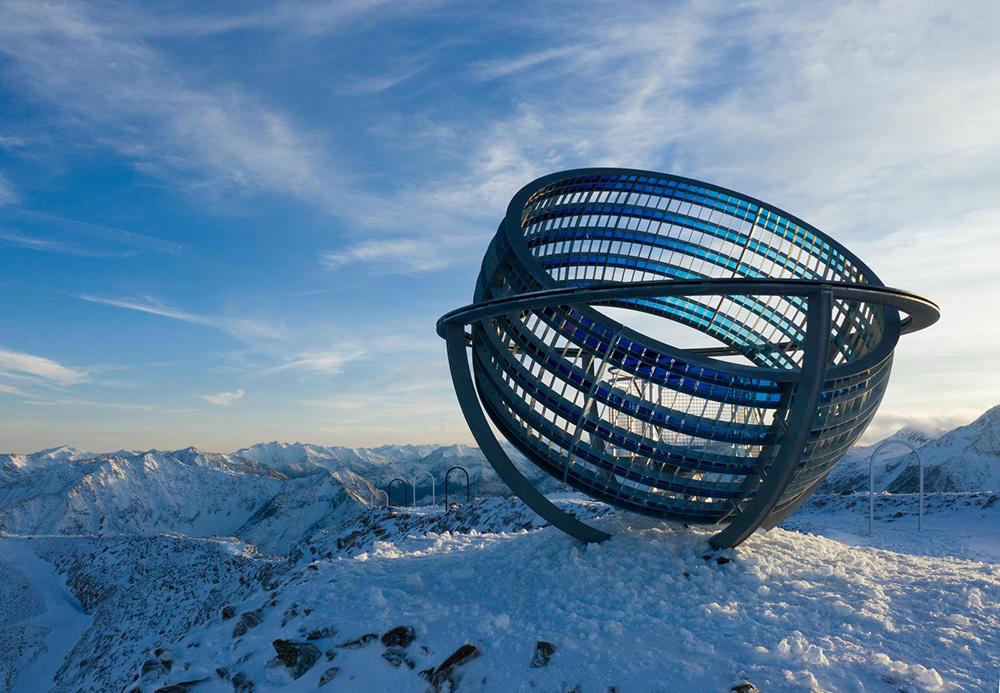
Olafur Eliasson, Our glacial perspectives, 2020. Grawand Mountain, Hochjochferner glacier, South Tyrol, Italy. Photo: Oskar Da Riz.
Eliasson’s paintings can be situated within his long-term aim to use works of art to focus viewers’ attention on their surroundings—on the earth’s motion, our perceptions of the sun’s and moon’s trajectories, the passage of time, and the changing condition of climate and the larger global ecology. Eliasson has often taken natural materials—water and ice for instance—as the very media from which his art is constructed, rather than treating them solely as subject matter. A number of his earlier projects, such as Our glacial perspectives (2020), were deliberately designed to “direct the visitor’s attention to larger planetary perspectives on the changes in the climate.”3 The large-scale, deep-time work Our glacial perspectives, mounted on a viewing platform atop a glacier-carved mountain in Tyrol, Italy, contains an astronomical viewing device with blue-tinted glass panes that resemble a cyanometer. The artist describes the work’s deliberate manipulation of attention as the creation of “an optical device” that produces an “embodied position” of a viewing subject.4
Similarly, the recent paintings Colour experiment no. 97 (2020), Colour experiment no. 101 (2020), and Colour experiment no. 113 (2021) pay careful attention to the viewing experience, which, as noted, changes dramatically as the field of vision is filled with color on approach. Distortion as an integral feature of perception is another recurring theme in Eliasson’s work, and these paintings sometimes play tricks with light and reflection. Through such deliberate manipulations of the viewing experience, Eliasson’s work intersects with a long history of artists’ interests in the relation between optical technologies and modes of attention. The tricks of anamorphic projection, as in Hans Holbein the Younger’s The Ambassadors (1533), the multiple levels of reflection in Jan Van Eyck’s The Arnolfini Portrait (1434), and M.C. Escher’s twentieth-century graphic illusions, which he produced using mathematical calculation, are vivid examples of the connections between visual distortion and the absorption of attention it can produce. The images sustain our engagement as we try to figure out how the illusion is produced in the relation between what is represented and the position from which we perceive it.
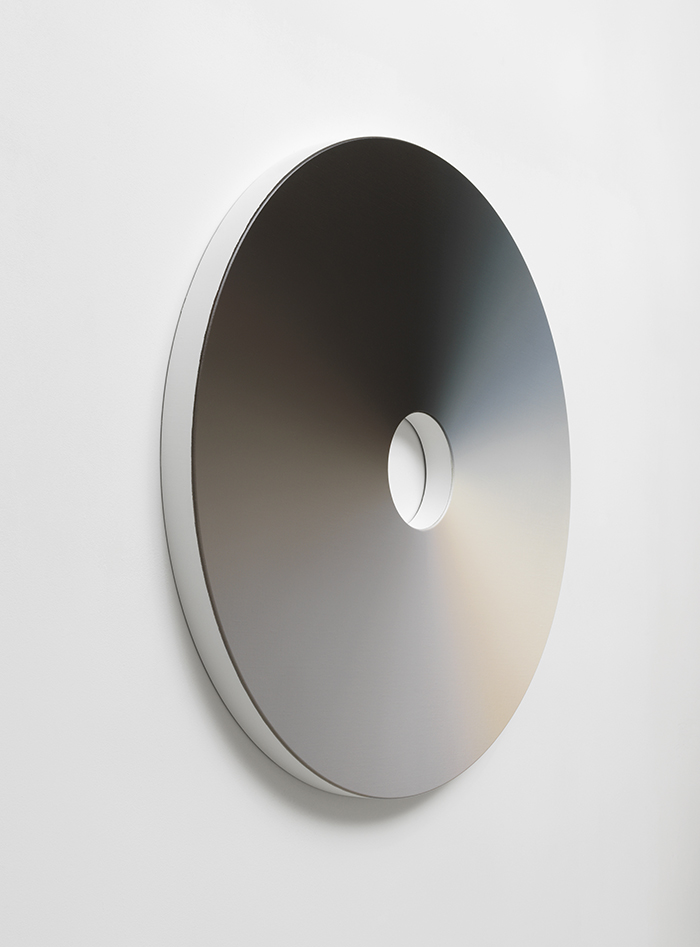
Olafur Eliasson, Colour experiment no. 87, 2019. Oil on canvas, 49 1/4 × 49 1/4 × 2 inches. Courtesy of the artist and Tanya Bonakdar Gallery, New York/Los Angeles.
Eliasson’s study of the rainbow builds on a tradition of human fascination with prismatic effects. The scattering of the spectrum of visible light to reveal its complex composition tracks back in Western science to antiquity. Aristotle was fascinated by rainbows, and through direct observation of the way they were produced by water droplets suspended in the atmosphere, he formulated a theory of the way light is refracted into discrete wavelengths. His attention was not directed by any technology beyond the keen observations of his naked eye, nor did his observations of the atmosphere reveal changing conditions on a fragile globe.
The development of optical technologies has had many phases. Aristotle understood that a pinhole in an opaque surface could be used to produce a viewable image of an eclipse.5 These ancient techniques produced an assisted optics of attention and focus on which Eliasson still draws, even as newer, digital imaging extends the long history of analogue effects in innovative ways. Isaac Newton’s 1704 publication, Opticks, contained breakthroughs in the study of refraction and its scattering effects. Newton’s realization that a prism could separate a beam of white light into the colors of the rainbow made Eliasson’s detailed studies of spectra possible. Newton’s observations were augmented by other new technologies, including the telescope and the microscope. Together, these tools revealed life below the level of sight and worlds beyond it, extending vision beyond the range of the unaided human eye. Eventually, this science led to the study of visible light at the granularity of a nanometer.
The visible spectrum is only a small segment of the phenomena of light. Beyond the realm of visible light, the broader spectrum has become an integral aspect of contemporary optical technologies. To take a current and dramatic example of the way representations use visual representation to render non-visible phenomena, the recently published “images” from the James Webb Space Telescope are based on infrared signals processed from the non-visible areas of the electromagnetic spectrum.6 These startling and fascinating images are visualizations of data that has been computationally processed to create “pictures” of electromagnetic phenomena that allow us to “see” these non-visible wavelengths. The images displayed onscreen are remote, in all senses, from the natural phenomena on which they are based, and this distance introduces yet another confusion between phenomena and representation.
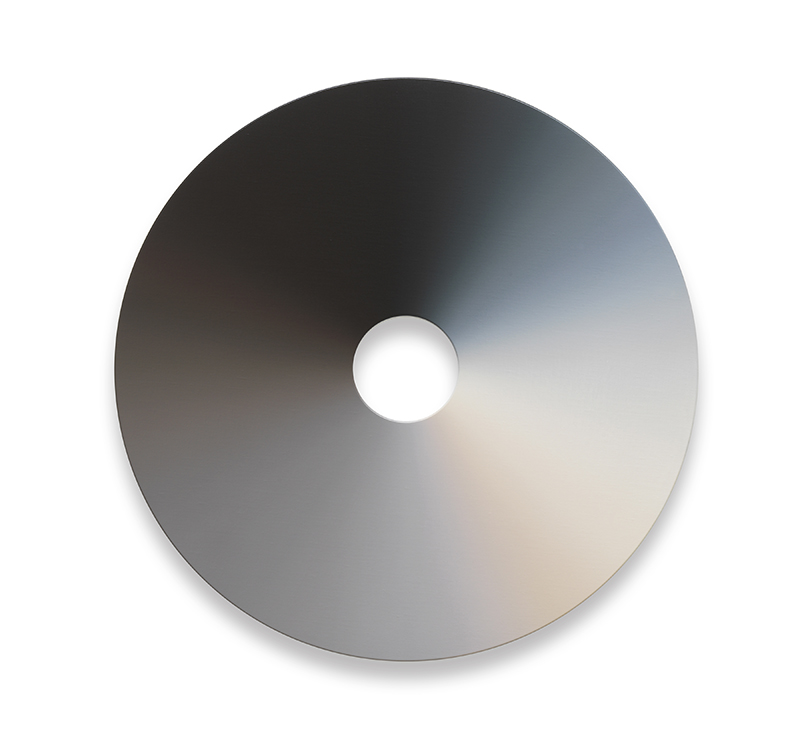
Olafur Eliasson, Colour experiment no. 87, 2019. Oil on canvas, 49 1/4 × 49 1/4 × 2 inches. Installation view, Tanya Bonakdar Gallery, Los Angeles, February 12–March 26, 2022. Courtesy of the artist and Tanya Bonakdar Gallery, New York/Los Angeles.
Over time, the prophylactic extension of vision beyond the capacity of the naked eye—through eyeglasses, magnifying lenses, telescopes, and microscopes— has produced ways to discipline and manage attention. Eliasson’s work uses techniques based on a framework of optical effects that has its roots in modern popular—as well as scientific—culture. These histories are so familiar that they disappear, and yet they feed our aesthetic imagination as well as provide a basis for our experience. As the devices of visual culture proliferated, they competed for attention in theater, puppet shows, camera obscuras, shadow plays, panoramas, stereoscopes, phenakistoscopes, cinema, television, and the screens of multiple devices. The relation between visual experience, optical technologies, and cultural patterns of attention is complex. But popular punditry and scholarly studies speculate that, in the current moment, human attention is unprecedentedly refracted, scattered, and segmented, as we constantly swipe and click through one screen and device after another. Whether this hyper-stimulation will produce new forms of attention—even modifying our brains and capacities to process multi-modal communication—as an evolutionary adaptation remains to be seen.
The issue of attention that weaves through Eliasson’s work, however, links it persistently to the issue of climate change. Again, this has a history within which his work can be contextualized. The most poignant feature of the history of painting of light, spectra, and color is the way that artists’ representations of specific atmospheric phenomena record climatic conditions at different moments in time. For example, many of the renowned canvases of Romanticism and Impressionism are now being reviewed for information about the effects of industrialization. By the time J.M.W. Turner was making highly aesthetic images of steam being emitted from railway engines in the 1840s, the air of cities was already dark with pollution, and countryside collieries belched fumes into the rural air. Even earlier, in 1824, the French physicist Jean-Baptiste Joseph Fourier recorded that human intervention had altered natural conditions at a considerable scale. Later in that decade, the British government began to make inquiries into the relationship between pollution and public health. By the 1890s, the first calculations of greenhouse gases were made by the Swedish scientist Svante Arrhenius. His colleague Arvid Högbom identified their sources in some of the same industrial effluvia being depicted by landscape painters as atmospheric effects. Eliasson’s Colour experiment no. 87 (2019), a careful study of Caspar David Friedrich’s atmospheric Der Wanderer über dem Nebelmeer (Wanderer above the sea of fog, c. 1818), might well contain a spectral study of climate conditions within its Romantic atmospheric effects.
Nineteenth-century painters, enthralled with theories of optics, perception, and color, were working within an increasingly polluted and visually cluttered world.7 Yet, in 1861, Frederick Church painted The Icebergs as an image of the sublime in nature without irony or critical questioning. His approach embodied the ideology of his time: natural grandeur existed beyond the scale—and interference—of humankind. By contrast, in Ice Watch (2014), Eliasson hauled the massive fragments of a calved giant iceberg into view in two outdoor locations in London—Bloomberg’s European headquarters and the Tate Modern—in 2018. The sight of the melting chunks combined a sense of inevitability and pathos far from the sublime.
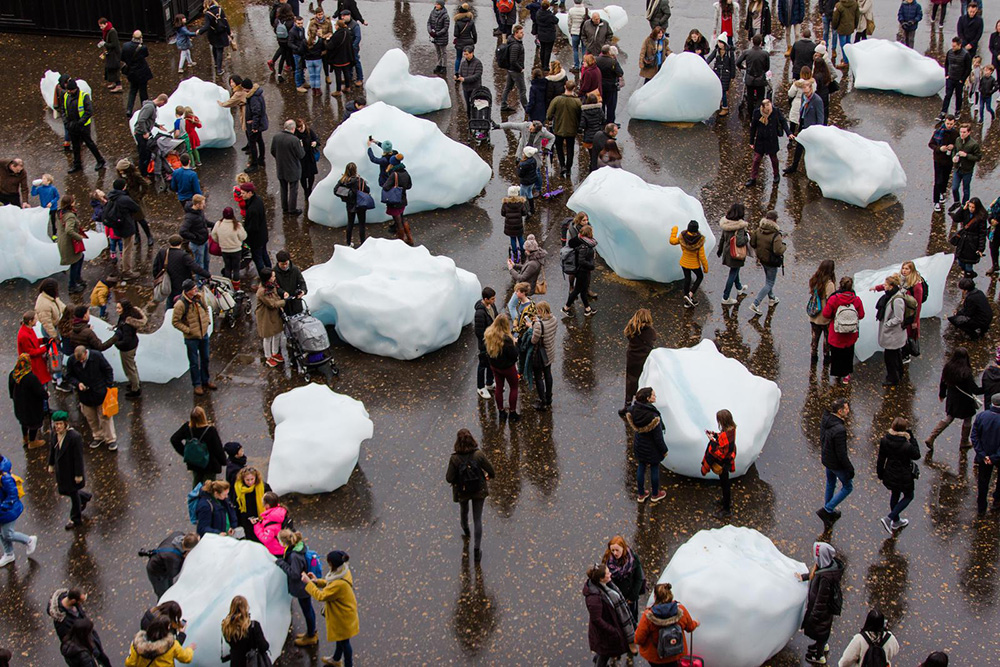
Olafur Eliasson, Ice Watch, 2014. Bankside, outside Tate Modern, London, 2018. Photo: Charlie Forgham-Bailey.
In the current exhibit, Eliasson’s paintings don’t reveal whether the rainbows he invokes are affected by pollution—if they shift color or are otherwise perceived differently through the haze of an ozone-ridden sky. Given the environmental concerns that have motivated many of his other projects, one would be forgiven for thinking they should.
Inevitably, each technology of optical investigation and fine art practice organizes visual experience differently. Some focus attention. Others refract it. Breaking attention into wavelengths to disperse it across a spectrum creates a segmented field—metaphorically as well as physically. This refraction applies to topics and agendas, as well as light and color. What may once have been a unified field of visual experience has been fragmenting into rapidly shifting and constantly demanding spaces of attention and distraction since the explosion of visual culture that accompanied industrialization. Focusing this scattered attention on the impending climate catastrophe has real urgency.
Johanna Drucker is the Breslaeur Professor and Distinguished Professor of Information Studies at UCLA. She is internationally known for her work on information visualization, digital humanities, the history of writing, and visual art. Recent publications include Inventing the Alphabet (University of Chicago, 2022) and Iliazd: Meta-biography of a Modernist (2021).
